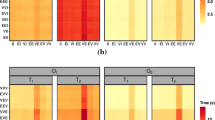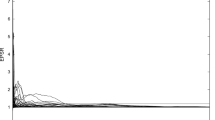Abstract
In this paper, we propose a higher-order interactive hidden Markov model, which incorporates both the feedback effects of observable states on hidden states and their mutual long-term dependence. The key idea of this model is to assume the probability laws governing both the observable and hidden states can be written as a pair of higher-order stochastic difference equations. We also present an efficient procedure, a heuristic algorithm, to estimate the hidden states of the chain and the model parameters. Real applications in SSE Composite Index data and default data are given to demonstrate the effectiveness of our proposed model and corresponding estimation method.




Similar content being viewed by others
References
Bard JF (1998) Practical bilevel optimization: algorithms and applications. Kluwer Academic Publishers, Dordrecht
Berry M, Browne M, Langville A, Pauca V, Plemmons RJ (2007) Algorithms and applications for approximate nonnegative matrix factorization. Comput Stat Data Anal 52:155–173
Chan R, Ching W (1996) Toeplitz-circulant preconditioners for toeplitz systems and their applications to queuing networks with batch arrivals. SIAM J Sci Comput 17:762–772
Ching W, Choi S, Li T, Leung I (2009) A tandem queueing system with applications to pricing strategy. J Ind Manag Optim 5:103–114
Ching W, Fung E, Ng M (2004b) Higher-order Markov chain models for categorical data sequences. Int J Nav Res Logist 51:557–574
Ching W, Fung E, Ng M, Siu T, Li W (2007) Interactive hidden Markov models and their applications. IMA J Manage Math 18:85–97
Ching W, Ng M (2006) Markov chains : models, algorithms and applications. International series on operations research and management science. Springer, New York
Ching W, Ng M, Wong K (2004a) Hidden Markov model and its applications in customer relationship management. IMA J Manage Math 15:13–24
Choi S, Huang X, Ching W, Huang M (2011) Incentive effects of multiple-server queueing networks: the principal-agent perspective. East Asian J Appl Math 1:379–402
Chu M, Diele F, Plemmons R, Ragni S (2005) Optimality, Computation and Interpretation of Nonnegative Matrix Factorizations, Preprint, Available from: http://www4.ncsu.edu/~mtchu/Research/Papers/nnmf.ps
Cutland NJ, Kopp PE, Willinger W (1993) From discrete to continuous financial models: new convergence results for option pricing. Math Financ 3:101–123
Cutland NJ, Kopp PE, Willinger W (1995) Stock price returns and the Joseph effect: a fractional version of the Black-Scholes model. Prog Probab 36:327–351
Elliott RJ, Aggoun L, Moore JB (1994) Hidden Markov models: estimation and control. Springer-Verlag, Berlin-Heidelberg-New York
Girardin E, Joyeux R (2013) Macro fundamentals as a source of stock market volatility in China: A GARCH-MIDAS approach. Econ Modelling 34:59–68
Leung K, Kwok Y (2009) Counterparty risk for credit default swaps: Markov chain interacting intensities model with stochastic intensity. Asia Pacific Financ Mark 16:169–181
Lin C (2007) Projected gradient methods for non-negative matrix factorization. Neural Comput 19:2756–2779
Lee D, Seung H (1999) Learning the parts of objects by nonnegative matrix factorization. Nature 401:788–791
MacDonald I, Zucchini W (1999) Hidden Markov and other models for discrete-valued time series. Chapman and Hall, London
Paatero P (1999) The multi-linear engine-A table-driven least squares program for solving multi-linear problems, including the \(n\)-way parallel factor analysis model. J Comput Gr Statist 8:1–35
Paatero P, Tapper U (1994) Positive matrix factorization: a non-negative factor model with optimal utilization of error estimates of data values. Environmetrics 5:111–126
Peiró A (2016) Stock prices and macroeconomic factors: some European evidence. Int Rev Econo Financ 41:287–294
Rabiner L (1989) A tutorial on hidden Markov models and selected applications in speech recognition. Proc of the IEEE 77:257–286
Raftery A (1985) A model for high-order Markov chains. J R Stati Soc B 47:528–539
Saul L, Jordan M (1999) Mixed memory Markov models : decomposing complex stochastic processes as mixtures of simpler ones. Mach Learn 37:75–86
Siu T, Ching W, Ng M, Fung E (2005) On a multivariate Markov chain model for credit risk measurement. Quant Financ 5:543–556
Siu T, Ching W, Fung E, Ng M, Li X (2009) A high-order Markov-switching model for risk measurement. Comput Math Appl 58:1–10
Tong H (1990) Non-linear time series: a dynamical system approach. Oxford University Press, Oxford
Yang H, Li Y, Lu L, Qi R (2011) First order multivariate Markov chain model for generating annual weather data for Hong Kong. Energy Build 43:2371–2377
Acknowledgements
The authors would like to thank AE and tow referees for their detailed comments and suggestions. This research work is supported by Research Grants Council of Hong Kong under Grant Number 17301214 and HKU CERG Grants, HKU Strategic Research Theme on Computation and Information, National Natural Science Foundation of China Under Grant number 71501093 and 71601044, the Basic Research Foundation (Natural Science) of Jiangsu Province with Grant number BK20150566 and Fundamental Research Funds for the Central Universities with number 011814380024.
Author information
Authors and Affiliations
Corresponding author
Rights and permissions
About this article
Cite this article
Zhu, DM., Ching, WK., Elliott, R.J. et al. A Higher-order interactive hidden Markov model and its applications. OR Spectrum 39, 1055–1069 (2017). https://doi.org/10.1007/s00291-017-0484-0
Received:
Accepted:
Published:
Issue Date:
DOI: https://doi.org/10.1007/s00291-017-0484-0




